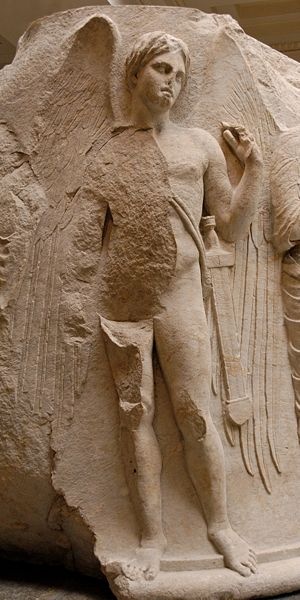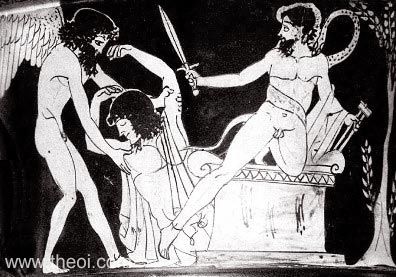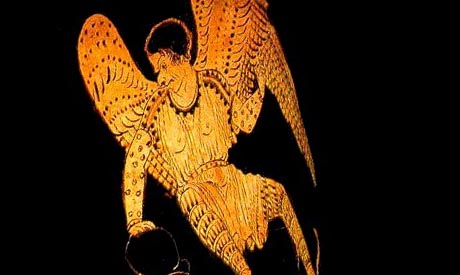You are currently browsing the tag archive for the ‘Thanatos’ tag.
In ancient Greece, there were two incarnations of death. The more well-known Greek personification of Death was Thanatos, the child of Nyx and brother of Hypnos (Sleep). Thanatos represented natural death and was portrayed as a gentle being. He was represented either as a kind handsome bearded man with wings or as a beautiful winged child. Thantos is sometimes portrayed carrying a butterfly, a wreath, or an inverted torch. Thanatos is frequently represented on funerary stele and on vases—a peaceful figure who led souls away after they had lived full lives.
However Thanatos had a flock of hellish sisters, the Keres, dark flying beings with sharp teeth and an insatiable taste for blood. The Keres represented violent senseless death. They flew in the thousands above battlefields and hung over plague ravaged cities. The Keres were associated with the apparatus of violent death–famine, madness, agony, hate, and violence, yet classical authors also sometimes treat them as oddly personal—like a bullet with a soldier’s name on it. Keres were portrayed like harpies or demons—cruel women with fangs and talons dressed in bloody ripped garments. When they found a wounded or sick person the Keres would descend to feast on blood. Hesiod’s harrowing poem, The Shield of Heracles describes them in such a manner:
The black Keres, clashing their white teeth,
Grim faced, shaggy, blood-bespattered, dread,
Kept struggling for the fallen. They all wanted
To drink black blood. Whom first they caught.
Lying or fallen newkly wounded, around him
They threw their might talosns, and the shade to Hades
Went, in icy Tartarus. Their hearts were glutted
With human blood: they threw away the corpse
And back to the tumult and fighting rushed, in new desire
(verses 248-257)
Hesiod also indirectly indicates that the Keres were among the horrible fates which flew out of Pandora’s box and have subsequently plagued mankind. The Romans also believed in these cruel & deadly incarnations of fat. The Roman name for the entities was tenebrae—“darknesses”
The Keres do not fit neatly into the larger Greco-Roman pantheon. Perhaps, like Nyx herself, they were outsider gods left over from some earlier tradition. Throughout the course of classical history, their portrayal and their fatalistic meaning changed. However they were a part of classical thought. It is important to mention them when writing about the Greek underworld. The dark realm below was haunted by these cruel children of night—they would fly forth when disaster struck humankind.



